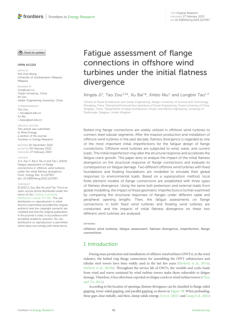Non Destructive Testing (NDT) 1980 - 2023

Authors: W.D. Dover, R. Collins, D. H. Michael
Ac-field measurement technique measures and interprets
field perturbations in a region containing a surface flaw.
ACPD, as it was originally called, has a long history of
malpractice but was so eminently suitable for laboratory
monitoring of fatigue cracks that it was reassessed for this
purpose. The technique consists of impressing an AC
current into the region containing the flaw and exploring
the surface—voltage distribution with a probe.

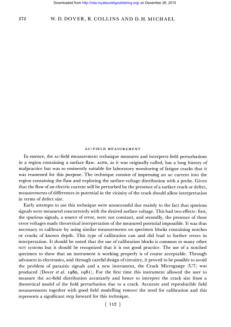

Initially edited in hard copy, this book was considered one
of the most relevant documents when published. Apart
from some new technologies that did not exist when it
was written, we can say that this document is still actual
and should be considered a reference.
Note that this is a big file, and downloading it takes time.

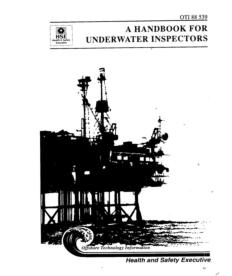

Authors: A.I.Bondarenko, E.O.Paton
Extended welded pipelines are characterized by the
presence of various discontinuities in them related to the
change of material density and/or cross-section of pipe
walls on their joint boundary and/or along the pipe
length. This paper deals with detecting these
discontinuities, with which low-frequency guided waves
of longitudinal and torsional modes interact during their
propagation in the form of a circular wave through the
pipe cross-section.

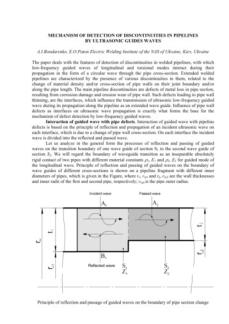

Author not indicated
Ultrasonic Testing (UT) uses high frequency sound energy
to conduct examinations and make measurements.
Ultrasonic inspection can be used for flaw
detection/evaluation, dimensional measurements, material
characterization, and more. To illustrate the general
inspection principle, a typical pulse/echo inspection
configuration as illustrated below will be used.

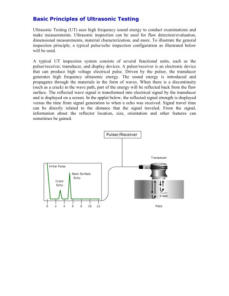

Author unknown
This presentation provides information on magnetic
particle inspection methods (MPI).
It can be used to teach divers on the purpose and
implementation of such procedures during mobilization
and maintenance. This document does not explain
underwater MPI.

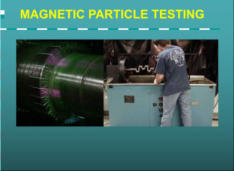

Publisher: Mark Stephen Rogers
This presentation shows the applications, advantages and
disadvantages of various Non-Destructive Techniques
(NDT) used in multiple industries, particularly in the
offshore and petroleum industries.

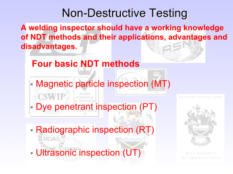

This document can be classified under the “Technical
document - Vessels” rubric. Nevertheless, it provides
guidelines that can be used to organize inspections.

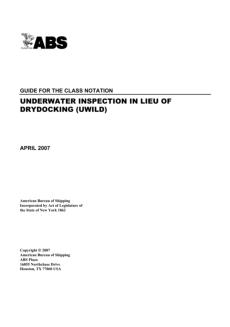

Author:
Reza K. Amineh, Maryam Ravan, Hesamedin Sadeghi, and
Rouzbeh Moini
In the alternative current field measurement (ACFM)
technique, the nonzero value of liftoff distance for the
magnetic sensor acts as a low-pass filter on surface crack
signals, causing errors in crack detection and sizing. The
authors present a blind deconvolution algorithm for Liftoff
evaluation and surface crack signal restoration.

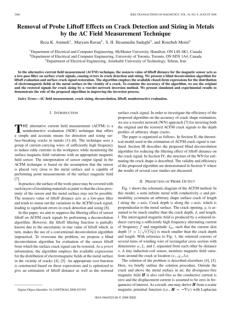

Publisher: Siemens Rolling Stock Pvt. Ltd, Aurangabad
This presentation can be used to inform personnel on
ultrasonic testing

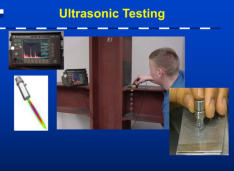

Publisher: International Atomic Energy Agency
Even though this document is not specifically designed for
diving activities, it provides essential information regarding
Eddy Current.


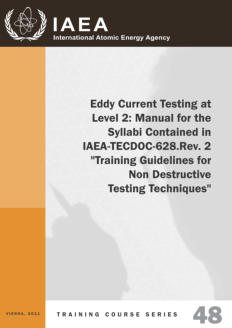

Publisher: Dzevad Hadzihafizovic
This handbook provides basic information about weld
conditions, gauges, symbols, and weld terms.


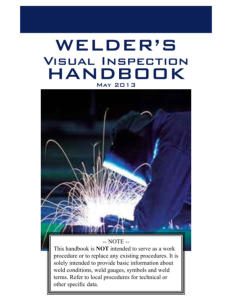

Authors:
Jasper A. Agbakwuru, Ove T. Gudmestad, John Groenli,
Helge Skjaveland
This paper demonstrates a technique for tracking and
identifying leaking points on pipelines installed in
unclear/muddy water conditions using optical cameras.
The method leads a remotely operated or hyperbaric
system to the leak in muddy water conditions for close
visual inspection and subsequent repair.


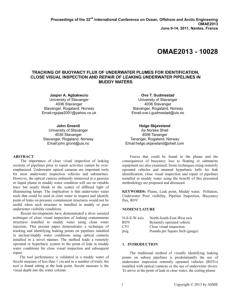

Authors:
Ken Woolley, Tim Woolley, and Bruce Banfield
Since the beginning, underwater MPI has been carried by
night due to the inks' characteristics. New inks are now
available, although they are for topside use and thus are
not necessarily applicable to underwater conditions.
Recent trials have been conducted to determine the
suitability of available inks to increase white light levels
underwater. This paper presents the work and discusses
the findings, which have application worldwide.


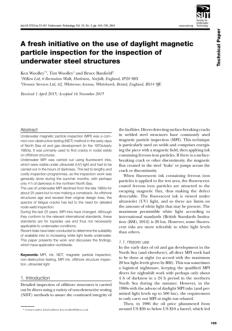

Publisher: Frontline
This document provides procedures for visual and optical
inspection according to “Frontline”, a company specialised
in non destructive techniques
(https://frontlinetesting.com/ )


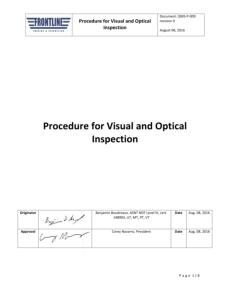

Authors: Restu Putra & Ahmad Irsyad
This presentation is another document that can be used to
initiate personnel to Eddy Current inspection.


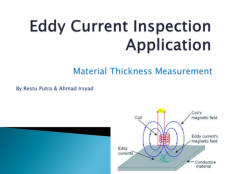

Author: Mark W Hounslow
Particulate matter derived from various fuel combustion
sources contains minor to trace amounts of Fe-oxides that
magnetic measurements can detect. These magnetic
particulates can be used as proxies for particulate pollution
since oxide contents are often more significant in
quantities and may have distinctive magnetic properties
compared to most types of natural dust.


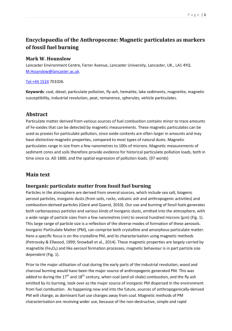

Author:
Ali Khaloo , David Lattanzi, Adam Jachimowicz, and
Charles Devaney
This paper presents a case study where photogrammetry
was used to create comprehensive and high-resolution
3D point clouds of a dam and surrounding environment
at intervals. These models were then assessed for their
quality and ability to resolve defects that were artificially
applied to the structure between inspection intervals. The
results indicate that the integrated process can generate
models that accurately render various defect types with
sub-millimeter accuracy.


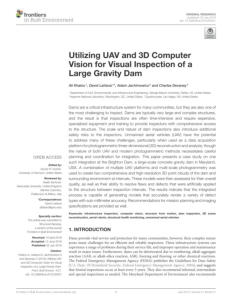

Authors: Restu Putra & Ahmad Irsyad
This presentation is another document that can be used
to initiate personnel to Eddy Current inspection.


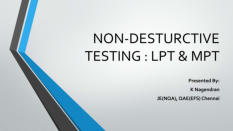

Publisher: International Atomic Energy Agency
Even though this document is not specifically designed for
diving activities, it provides essential information regarding
the use of NDT .
The organization for which it has been designed is proof
of quality.


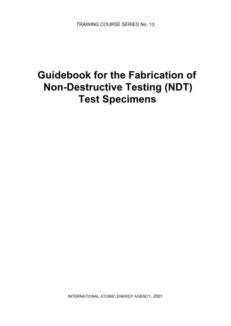

This is another document from the International Atomic
Energy Agency, not specifically designed for diving
activities, that provides essential information regarding the
use of NDT.

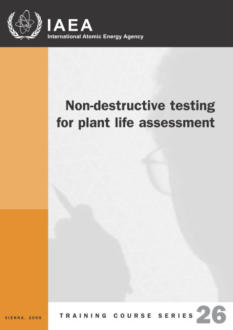



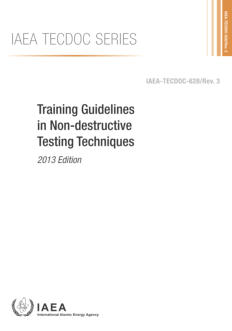

Tomography is an x-ray technique in which shadows of
superimposed structures are blurred out by a moving x-ray
tube. This method is used in radiology, archaeology,
biology, atmospheric science, geophysics, oceanography,
plasma physics, materials science, astrophysics, quantum
information, and other areas of science.
This document is provided by the International Atomic
Energy Agency.


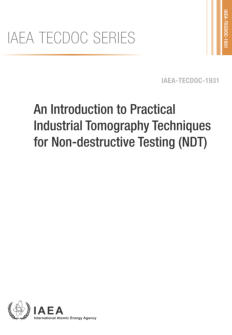



Authors: Duje Medak, Luka Posilovic, Marko Subasic,
Marko Budimir, Sven Loncari
Most ultrasonic data collection has recently become
automated, but the analysis of this data is still done
manually. This makes it expensive, inconsistent, and prone
to errors. An automated system could make processes
much more efficient, but the current methods are not
effective. Deep learning could be a more effective
approach for analyzing this data, as it has been successful
in similar cases. Based on this, the authors utilized a deep
learning model called EfficientDet to automatically detect
defects in ultrasonic images.

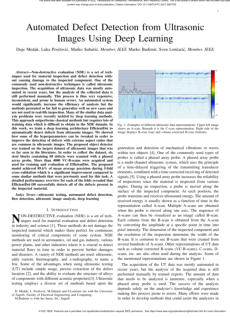

Authors: Chao Chen, and Xingyuan Zhang
A support vector machine-based method is proposed to
solve the challenge of accurately quantifying surface
defect depth during laser ultrasonic inspection. A finite
element model for laser ultrasound inspection of
aluminum materials with surface defects was developed
using COMSOL software, based on the thermal-elastic
mechanism.

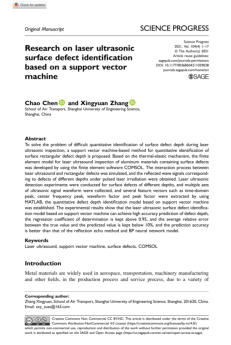

Authors: Xiaofei Li, Heming Sun, Taiyi Song, Tian Zhang,
Qinghang Meng
This study focuses on the detection and identification of
structural cracks in underwater bridge structures using
advanced image recognition networks. It compares
different networks and outlines the methodology,
including ablation experiments to evaluate the
performance and accuracy of various network
combinations in identifying underwater structural
damage.

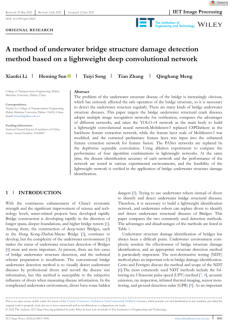

Authors: Sheng Shen, Zheng Cao, & Changqin Lai
This document describes the development of a sonar
scanning scheme designed explicitly for inspecting
underwater high-rise pile cap foundations (HRPCFs). The
goal is to enhance the efficiency of bridge inspections and
extend the structural durability of these foundations. It
discusses the experimental determination of critical factors
affecting sonar measurement accuracy, the design of a
platform to hold and move the sonar device under strong
currents, and the strategy for optimal placement of
measurement points to avoid signal obstruction.

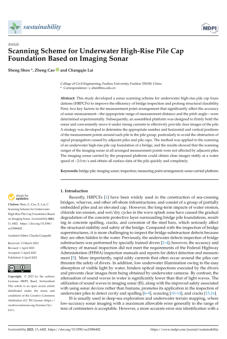

Publisher:
UK-HSE
This document is designed to guide plant engineers and
inspection personnel on methods for analyzing and
extrapolating inspections for large plant items, including
vessels, pipework, and pipelines, while considering the
statistical nature of corrosion. It aims to introduce methods
of statistical analysis of corrosion inspection data. Before
incorporating the methodology into standards, practical
experience in industrial applications is necessary to identify
the most relevant distributions and statistical techniques.


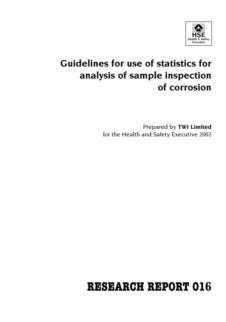

Publisher: UK HSEi
The document intends to inform the reader about the
importance of ultimate strength analysis in assessing the
robustness of offshore platforms and how this analysis can
be used to optimize inspection planning. It highlights the
role of EQE International, Inc. in conducting a study for
the Health and Safety Executive (HSE) to explore the
relationship between platform robustness and inspection
requirements.

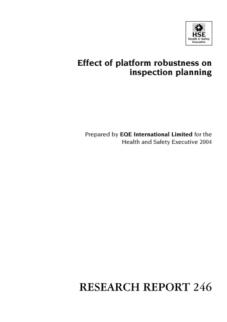

This document describes the process and methodology of
the specific inspection project, Key Programme 3,
conducted by the HSE Offshore Division between 2004
and 2007. It explains how inspections were carried out,
the scoring system used (traffic lights), the roles of the
inspectors, and how the results were evaluated and
recorded, and provides an overview of the inspection
process, including the criteria for compliance and the
evaluation of safety-critical elements.

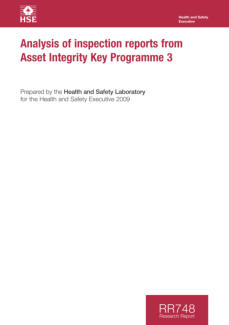

Author: Junfeng Fan, Yaming Ou, Xuan Li, Chao Zhou,
and Zengguang Hou
This document describes a new method for inspecting
underwater pipelines using underwater vehicles equipped
with structured light vision (SLV) technology. The text
outlines the limitations of current inspection methods and
introduces a proposed solution that involves a dual-line
laser SLV system. This system aims to improve precision,
resolution, and information capture for fine three-
dimensional reconstruction of underwater pipelines. The
text also highlights the integration of this technology with
the BlueROV underwater vehicle and presents
experimental results demonstrating the effectiveness of the
method.


Author: Hwei-Yang Tan
This study develops a new approach for analyzing
corrosion in the oil and gas industry, addressing limitations
in current industrial practices and standards by
incorporating statistical methods that account for various
risk factors and the stochastic nature of localized corrosion.
It improves the prediction of the remaining useful life of
components in oil and gas plants by utilizing advanced
statistical techniques and software.


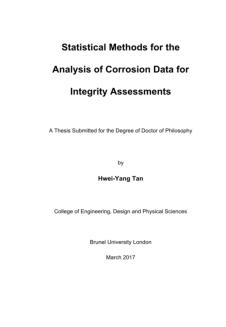
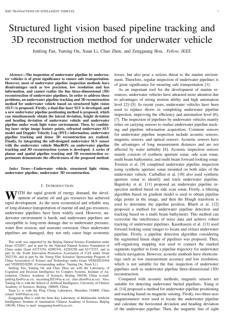

Authors: Franka Nauer, and Peter Kampmann
This paper analyzes the current state and challenges of
autonomous underwater intervention technology,
particularly focusing on the use of intervention
Autonomous Underwater Vehicles (AUVs) for inspection
and maintenance of underwater infrastructure. It identifies
key requirements and challenges in the development of
high-level autonomy for these vehicles, such as decision-
making, tool handling, and precise navigation, and further
research and development in this field.

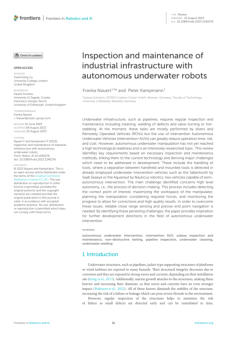

It can also be downloaded through this link:
https://webarchive.nationalarchives.gov.uk/ukgwa/20230
103120103/https://www.hse.gov.uk/research/otipdf/oti8
8539.pdf
Authors: Dr. John M. Webster. Dr Thanga Thevar. Tim
Schmidt. Jackie Mew
Corrosion in aluminium aircraft structures is a growing
issue in the aging fleet, which may affect safety. Existing
methods for detecting hidden corrosion are often slow
and not very accurate. Techniques like Thermal Wave
Imaging show promise, but challenges remain. Reliable
detection methods are still being developed, with early
results from Remote Acoustic Impact Doppler (RAID)
technology being presented.


3 - A New Computational Imaging Method for the Remote
Detection and Quantification of Hidden Corrosion
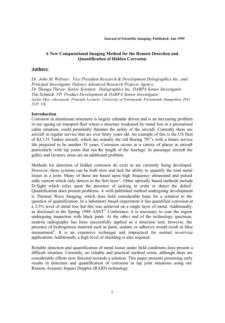
Authors: R. Raisutis, E. Jasituniene, R. Sliteris, A.
Vladisauskas
Wind power is a clean and renewable energy source
that requires regular inspection of wind turbine
components. This study reviews techniques for
monitoring and non-destructive testing (NDT) of wind
turbine blades, including vibration analysis,
thermography, X-ray imaging, acoustic emission, and
ultrasound. The goal is to assess various NDT methods
suitable for the complex structures of blades and harsh
conditions.


13 - The review of non-destructive testing techniques suitable for
inspection of the wind turbine blades
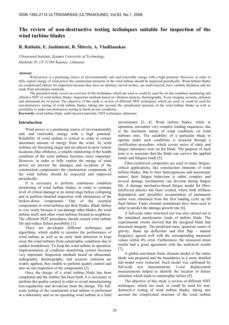
Authors: Peter W. Tse and J.M. Chen
The steel wire ropes used in elevators can rust and crack
due to exposure to salty air. Poor maintenance often
leads to accidents from broken wires. Current inspections
rely on human visual checks, which miss faults, especially
under grease. This study proposes an ultrasonic guided
wave technique for better detection of wire faults. Results
show that this method can find broken wires effectively,
even on greasy ropes, but needs further refinement for
on-site testing. Future research should focus on
improving operational parameters and developing
practical sensors.


21 - Effective Guided Wave Technique for Performing Non-
destructive Inspection on Steel Wire Ropes that Hoist Elevators
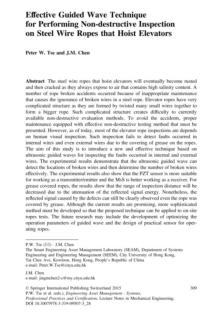





Click on the
octopus to return to
the top of the page
Authors: Scott Schecklman, and Lisa M. Zurk
Terahertz (THz) time of flight (TOF) tomography systems
provide a new method for non-destructive evaluation of
subsurface layers of protective coatings and laminated
composite materials. However, for thin film samples, the
time-of-flight within a layer is less than the duration of the
THz pulse, resulting in insufficient range resolution for
NDE. This paper applies matched field processing (MFP)
techniques to thickness estimation in THz TOF
tomography applications, using measured THz spectra to
estimate thin air gap thicknesses and depth below the
surface.


29 - Terahertz Imaging of Thin Film Layers with Matched Field
Processing
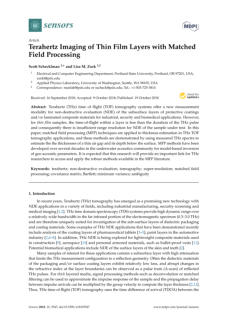
Authors: Thomas Scholz, Martin Laurenzis and Frank
ChristnacherSiermontowski,
This article discusses the evolution of underwater laser-
based imaging systems and data-processing techniques,
focusing on civil and naval applications in underwater
laser scanning (ULS) and laser gated viewing (LGV). It
emphasizes the importance of environmental conditions,
such as local and seasonal turbidity, and presents
advanced techniques for 3D laser oblique scanning (LOS)
and contrast enhancements for gated viewing based on
tank and sea experiments.


31 - Laser-based imaging applications in turbid waters
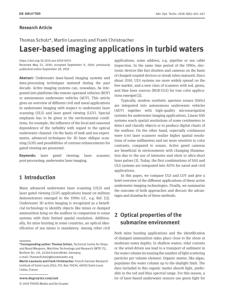
Authors: Noor Amila Wan Abdullah Zawawi, M.S. Liew,
Wesam Salah laloul, E. Lim, Muhammad Imran,
Iraj Toloue
Malaysia's offshore structures have reached the
decommissioning timeline due to extensive development
over 30 years. This paper discusses available
nondestructive test (NDT) techniques for underwater cut
detection in decommissioning projects. The paper reviews
past studies and techniques. It also discusses real
applications in the oil & gas industry with selected case
studies. The advantages and disadvantages of each
technique are compared to determine their suitability for
the decommissioning project.


32 - Non-Destructive Testing Techniques for Offshore Underwater
Decommissioning Projects through Cutting Detection: A State
of Review
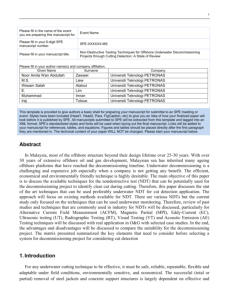
Authors: Jiannan Zhang, Younho Cho, Jeongnam Kim,
Azamatjon Kakhramon ugli Malikov, Young H.
Kim, Jin-Hak Yi, and Weibin Li
The thickness of a coating on ships or marine structures
affects its anti-corrosion performance and is evaluated
using ultrasonic Non-destructive testing (NDT). However,
the coating's high attenuation and absorption rates make
it difficult. The method suggested by the authors is based
on reflection coefficients and results in lower error.


34 - Non-Destructive Evaluation of Coating Thickness Using Water
Immersion Ultrasonic Testing
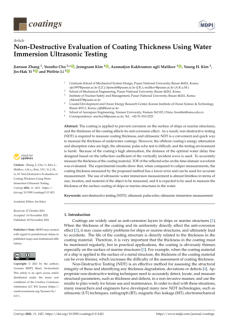

Authors: Seong Jin Lim, Young Lae Kim, Sungjong Cho,
and Ik Keun Park
Pipelines in industrial sites use different pipe shapes joined
through welding, including flanges, elbows, reducers,
and branch pipes. Inspecting these weld zones with
phased array ultrasonic testing (PAUT) is challenging due
to difficult probe access, small pipe diameters, and space
limitations. This study developed a flexible PAUT probe
(FPAPr) and a semi-automatic scanner to improve
inspection consistency. Mock-up tests with artificial flaws
verified their performance and applicability.


36 - Ultrasonic Inspection for Welds with Irregular Curvature
Geometry Using Flexible Phased Array Probes and Semi-Auto
Scanners: A Feasibility Study
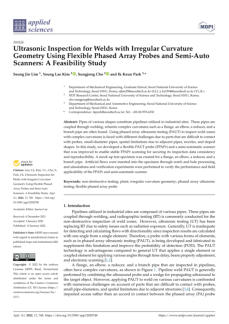
Authors:
Shoya Adachi, Minoru Hayashi, Taisei Kawakami, Yuto
Ando, Jin Wang, Kenji Sakai, Toshihiko Kiwa, Toshiyuki
Ishikawa, and Keiji Tsukada
This study investigates the use of non-destructive
inspection techniques to detect corroded steel sheet piles
at wharfs. Plate thickness measurement has been
previously demonstrated using low-frequency eddy
current testing. However, shellfish adhesion to steel piles
in water can cause a lift-off of several millimeters,
hindering thickness measurement due to magnetic signal
fluctuations. The study prototyped sensor probes with
different coil diameters to determine the optimal size for
high lift-off measurements.


38 - Thickness Measurement at High Lift-Off for Underwater
Corroded Iron-Steel Structures Using a Magnetic Sensor Probe
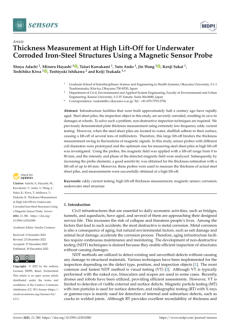

Authors: Xingda Ji, Tao Zou, Xu Bai, Xinbo Niu, and
Longbin Tao
Bolted ring flow connections are commonly used in
offshore wind turbines to connect steel tubular segments.
However, flow divergence is a significant initial
imperfection in the fatigue design of flow connections, as
it can alter the structural response and accelerate fatigue
crack growth. This paper aims to analyze the impact of
initial flow divergence on the structural response of flow
connections and its consequences on fatigue damage.
Two offshore wind turbines with fixed and floating
foundations are modelled to simulate their global
responses to environmental loads and fatigue assessments
are conducted on both types of turbines.


40 - Fatigue assessment of flange connections in offshore wind
turbines under the initial flatness divergence
